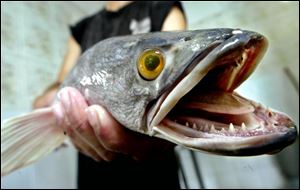
'Frankenfish' may be coming to water near you
6/20/2004Up 40 inches long, 15 pounds, and with a mouth full of big teeth and an appetite to match.
No, not a trophy northern pike or an up-and-coming muskellunge. Meet "Frankenfish." It may be living in an aquarium near you, or God forbid, in a
local stream or in Lake Erie.
It too easily could become the Next Big Thing to invade our precious Great Lakes environs if we - the collective, societal "we" - are careless or uncaring.
"Think of the implications of these things getting established in our Lake Erie tributaries, if not the lake itself," said Roger Knight, coordinator of Lake Erie programs for the Ohio Division of Wildlife.

A number of specimens of the Northern Snakehead, from China, have been caught in U.S. inland waters. The fish has the potential to be one of Lake Erie's worst invasive predators ever.
These things are northern snakeheads, a top-level predator fish native to China with the potential to wreak as much havoc as gobies, zebra and quagga mussels, sea lampreys, or the litany of other invader pests that increasingly are plaguing the Great Lakes. Or more.
The Maryland Department of Natural Resources, reacting to a snakehead infestation in a pond two years ago, said in part: ". . . the real threat is in its ability to live for days out of water and potentially wallow its way to other water bodies, or be spread by human intervention or flood."
Maryland authorities fear that the damnable pest may be trying to establish itself in the beloved Potomac River, which flows right through Washington D.C. and the political heart of America. A bass fishing competitor pulled a 13-incher from the river in May, the third such found in the stream in nine days.
Lest a panic erupt among Erie anglers, know that snakeheads in size and body-shape generally resemble two native species, the bowfin, or dogfish, and the burbot, or lawyer. Both are OK, if not deirable.
All three species have the same long, primitive "snaky" look, with long dorsal fins set well back. But the snakehead, unlike the bowfin, also has a long anal fin compared to the bowfin's short anal fin. The bowfin also has a rounded tail. The burbot has whiskers, or barbels on its lower jaw, a split dorsal fin, and a distended stomach. Too, the snakehead has dark, irregular blotches on its light-colored sides.
A critical, as-yet-unanswered question is whether snakeheads are reproducing in the Potomac - or any other native waterways in the country, for that matter. Snakeheads eat small fish, some frogs, and insect larvae and have the potential to displace large numbers of gamefish - which would be walleye, smallmouth bass, steelhead trout, and yellow perch in Lake Erie, for example. That alone makes it an attention-grabber.
The U.S. Fish & Wildlife Service, reacting to concerns over the snakehead time-bomb, says this:
"All species of snakeheads have recently been assigned injurious wildlife status under the Federal Lacey Act which prohibits the importation and interstate transportation of wildlife deemed by the Secretary of the Interior to be 'injurious' to humans, agriculture, or other wildlife resources. This includes both live snakeheads as well as viable eggs."
That said, know that there still are snakeheads around, brought here before the ban or slipped in through the black market trade. They are considered a food fish by some Asian cultures and a biggest-baddest-meanest pit bull of fish pets.
Just this spring an officer of the Ohio Division of Wildlife, acting on tip from a customer at a pet store in Lake County, east of Cleveland, discovered four 19-inch snakeheads swimming in an aquarium in said shop.
The 'heads were seized and presently were pickled, so to say, never to threaten Ohio again. The pet store proprietors were charged with illegal possession and offering for sale of live snakeheads, which also are banned by the state. The case is pending.
Why people do this is up for grabs, swirling around somewhere in the curious chemistry of the human mind.
"Same reason people have piranhas," said Kevin Kahle, supervisor of the state's Fairport Fisheries Research Station at Fairport Harbor. Or cougars, or black bears, or alligators, and such - none of which belongs anywhere but in its native wilds or in a zoo.
Dan Schneider, executive administrstrator of law enforcement for the wildlife division, said that the state has adopted a contact and cooperate policy regarding snakeheads. In short, if you have a live snakehead and want to get rid of it, do not dump it in a pond or stream or Lake Erie. Contact the state wildlife division, cooperate in turning it over, and you'll be thanked, not ticketed.
"But if someone's trying to sell one, they're in a whale of trouble," added the division's Knight. "The discouraging part for me is there are private owners and pet store owners that have these things, and it's important for the public to know it's illegal. The best strategy is to prevent them from being established in the first place."